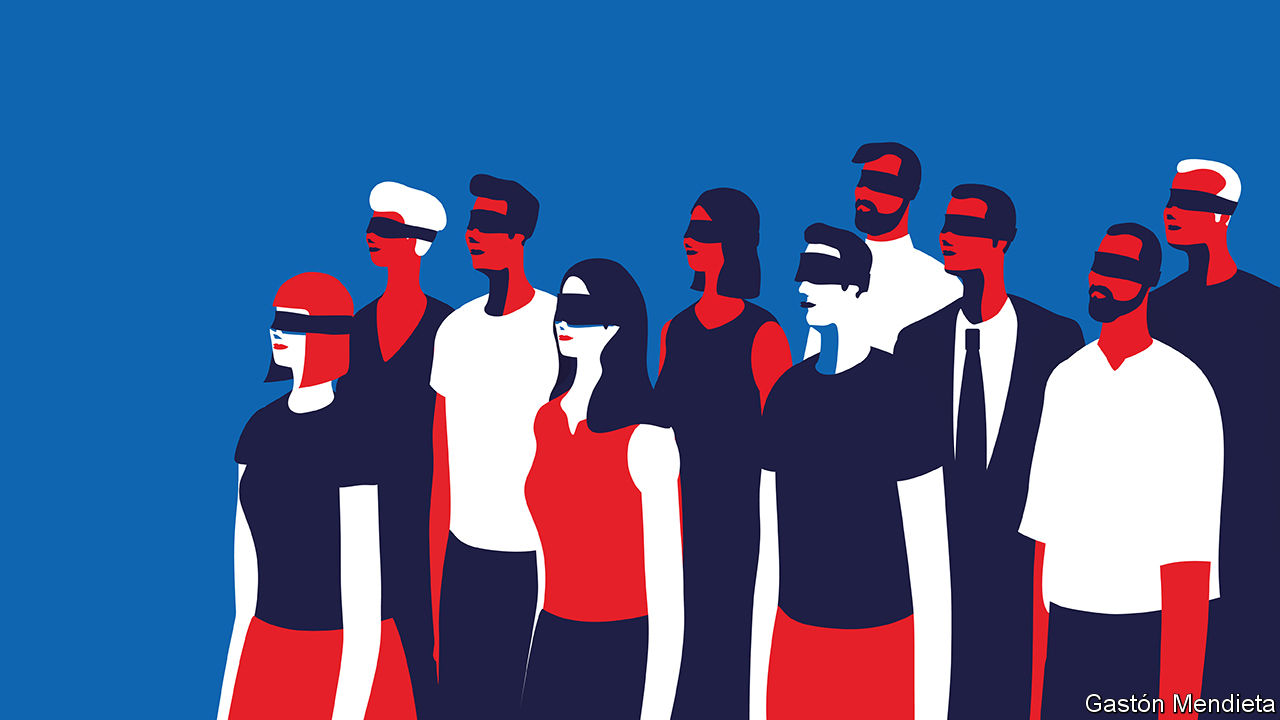Rawls rules
Three post-war liberals strove to establish the meaning of freedom
Berlin, Rawls and Nozick put their faith in the sanctity of the individual
ONE definition of a liberal is a person who supports individual rights and opposes arbitrary power. But that does not tell you which rights matter. For example, some campaigners say they want to unshackle transgender people, women and minorities from social norms, hierarchies and language that they see as tyrannical. Their opponents say that this means limiting what individuals do and say, for instance by censoring frank discussions of gender, or forbidding the emulation of minority cultures. Supporters of these kinds of “identity politics” claim to be standing up for rights against unjust power. But their opponents do, too. If both claim to be “liberal”, does the word mean much at all?
The problem is not new. Isaiah Berlin identified the crucial fault line in liberal thought in Oxford in 1958. There are supporters of “negative” liberty, best defined as freedom not to be interfered with. Negative liberties ensure that no person can seize his neighbour’s property by force or that there are no legal restrictions on speech. Then there are backers of “positive” liberty, which empowers individuals to pursue fulfilling, autonomous lives—even when doing so requires interference. Positive liberty might arise when the state educates its citizens. It might even lead the government to ban harmful products, such as usurious loans (for what truly free individual would choose them?).
Berlin spied in positive liberty an intellectual sleight of hand which could be exploited for harm. Born in Riga in 1909, he had lived in Russia during the revolutions of 1917, which gave him a “permanent horror of violence”. In 1920 his family returned to Latvia, and later, after suffering anti-Semitism, went to Britain. As his glittering academic career progressed, Europe was ravaged by Nazism and communism.
Under positive liberty the state is justified in helping people overcome their internal, mental vices. That lets government decide what people really want, regardless of what they say. It can then force this on them in the name of freedom. Fascists and communists usually claim to have found a greater truth, an answer to all ethical questions, which reveals itself to those who are sufficiently adept. Who, then, needs individual choice? The risk of a perversion of liberty is especially great, Berlin argued, if the revealed truth belongs to a group identity, like a class or religion or race.
To reject positive liberty is not to reject all government, but to acknowledge that trade-offs exist between desirable things. What, for example, of the argument that redistributing money to the poor in effect increases their freedom to act? Liberty must not be confused with “the conditions of its exercise”, Berlin replied. “Liberty is liberty, not equality or fairness or justice or culture, or human happiness or a quiet conscience.” Goals are many and contradictory and no government can infallibly pick among them. That is why people must be free to make their own choices about what constitutes good living.
Yet determining the proper sphere of that freedom has been the great challenge all along. One lodestar is the harm principle. Governments should interfere with choices only to prevent harm to others. But this is hardly a sufficient rule with which to exercise power, because there are plenty of harms that liberals typically do permit. An entrepreneur might harm an incumbent businessman by bankrupting him, for example. The most significant attempt of the 20th century to find a stronger boundary between the state and the individual was made by the Harvard philosopher John Rawls in 1971.
Rawls’s “A Theory of Justice” sold over half a million copies, reinvigorated political philosophy and anchored debates between liberals for decades to follow. It posited a thought experiment: the veil of ignorance. Behind the veil, people do not know their talents, class, gender, or even which generation in history they belong to. By thinking about what people would agree to behind the veil, Rawls thought, it is possible to ascertain what is just.
To begin with, Rawls argued, they would enshrine the most extensive scheme of inalienable “basic liberties” that could be offered on equal terms to all. Basic liberties are those rights that are essential for humans to exercise their unique power of moral reasoning. Much as Berlin thought the power to choose between conflicting ideals was fundamental to human existence, so Rawls argued that the capacity to reason gives humanity its worth. Basic liberties thus include those of thought, association and occupation, plus a limited right to hold personal property.
But extensive property rights, allowing unlimited accumulation of wealth, do not feature. Instead, Rawls thought the veil of ignorance yields two principles to regulate markets. First, there must be equality of opportunity for positions of status and wealth. Second, inequalities can be permitted only if they benefit the least well-off—a rule dubbed the “difference principle”. Wealth, if it is to be generated, must trickle all the way down. Only such a rule, Rawls thought, could maintain society as a co-operative venture between willing participants. Even the poorest would know that they were being helped, not hindered, by the success of others. “In justice as fairness”—Rawls’s name for his philosophy— “men agree to share one another’s fate.”
Rawls attributed his book’s success with the public to how it chimed with the political and academic culture, including the civil-rights movement and opposition to the Vietnam war. It demonstrated that left-wing liberalism was not dreamed up by hippies in a cloud of marijuana smoke, but could be rooted in serious philosophy. Today, the veil of ignorance is commonly used to argue for more redistribution.
Ironically, since 1971 the rich world has mostly gone in the opposite direction. Having already built welfare states, governments deregulated markets. Tax rates for the highest earners have fallen, welfare benefits have been squeezed and inequality has risen. True, the poorest may have benefited from the associated growth. But the reformers of the 1980s, most notably Margaret Thatcher and Ronald Reagan, were no Rawlsians. They would have found more inspiration in Rawls’s Harvard contemporary: Robert Nozick.
Nozick’s book “Anarchy, State and Utopia”, published in 1974, was an assault on Rawls’s idea of redistributive justice. Whereas Rawls’s liberalism relegates property rights, Nozick’s elevates them. Other forms of liberty, he argued, are excuses for the immoral coercion of individuals. People own their talents. They cannot be compelled to share their fruits.
Nozick questioned whether distributive justice is even coherent. Imagine some distribution of wealth that is deemed to be just. Next suppose that a large number of people each pay 25 cents to watch Wilt Chamberlain, then the top player in the NBA, play basketball. A new distribution would emerge, containing a very rich Mr Chamberlain. In this transition, people would have engaged in purely voluntary exchanges with resources that are properly theirs, if the initial distribution really is just. So what could be the problem with the later one? Liberty, Nozick said, disrupts patterns. Justice cannot demand some preferred distribution of wealth.
His work contributed to a philosophy in favour of small government that was blooming at the time. In 1974 Friedrich Hayek—Thatcher’s favourite thinker—won the Nobel prize in economics. Two years later it went to Milton Friedman. But although the world moved rightward, it did not shift far enough to become Nozickian. “Anarchy, State and Utopia” called for only a minimal, “nightwatchman” state to protect property rights. But vast government spending, taxation and regulation endure. Even America, despite its inequality, probably remains more Rawlsian.
Too much Utopia
Some of Rawls’s fiercest critics have been to his left. Those concerned with racial and gender inequality have often seen his work as a highfalutin irrelevance. Both Rawls and Nozick practised “ideal theory”—hypothesising about what a perfect society looks like, rather than deciding how to fix existing injustices. It is not clear, for example, whether Rawls’s principle of equality of opportunity would permit affirmative action, or any other form of positive discrimination. Rawls wrote in 2001 that the “serious problems arising from existing discrimination and distinctions are not on [justice as fairness’s] agenda.” Nozick acknowledged that his views on property rights would apply only if there had been no injustice in how property had been acquired (such as the use of slaves, or the forced seizure of land).
Rawls was also more concerned with institutions than with day-to-day politics. As a result, on today’s issues his philosophy can fire blanks. For example, feminists often say he did too little to flesh out his views on the family. His main prescription is that interactions between men and women should be voluntary. That is not much help to a movement that is increasingly concerned with social norms that are said to condition individual choices.

Rawlsianism certainly provides little to support identity politics. Today’s left increasingly sees speech as an exercise in power, in which arguments cannot be divorced from the identity of the speaker. On some university campuses conservative speakers who cast doubt on the concepts of patriarchy and white privilege, or who claim that gender norms are not arbitrary, are treated as aggressors whose speech should be prevented. The definition of “mansplaining” is evolving to encompass men expressing any opinion at length, even in writing that nobody is compelled to read. Arguments, it is said, should be rooted in “lived experience”.
This is not how a Rawlsian liberal society is supposed to work. Rawls relied on the notion that humans have a shared, disinterested rationality, which is accessible by thinking about the veil of ignorance, and is strengthened by freedom of speech. If arguments cannot be divorced from identity, and if speech is in fact a battleground on which groups struggle for power, the project is doomed from the outset.
Rawls thought that the stability of the ideal society rests on an “overlapping consensus”. Everyone must be sufficiently committed to pluralism to remain invested in the democratic project, even when their opponents are in power. The polarised politics of America, Britain and elsewhere, in which neither side can tolerate the other’s views, pushes against that ideal.
The more that group identity is elevated above universal values, the greater the threat. In America some on the left describe those who have adopted their views as “woke”. Some fans of Donald Trump—who has taken the Republican party a long way from Nozickian libertarianism—say they have been “red pilled” (a reference to the film “The Matrix”, in which a red pill lets characters realise the true nature of reality). In both cases, the language suggests some hidden wisdom that only the enlightened have discovered. It is not far from there to saying that such a revelation is necessary to be truly free—an argument that Berlin warned is an early step on the path to tyranny.
The good news is that pluralism and truly liberal values remain popular. Many people want to be treated as individuals, not as part of a group; they attend to what is being said, not just to who is saying it. Much hand-wringing about public life reflects the climate on social media and campuses, not society at large. Most students do not subscribe to radical campus leftism. Still, backers of liberal democracy would do well to remember that the great post-war liberals, in one way or another, all emphasised how individuals must be free to resist the oppression of large groups. That, surely, is where liberal thought begins.

 Aug 30th 2018
Aug 30th 2018
0 Comments